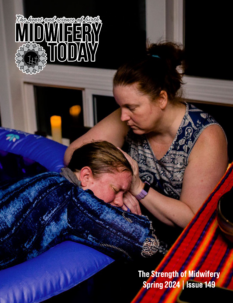
Photo by Jenna Norman
Early Trauma, Its Potential Impact on the Childbearing Woman, and the Role of the Midwife
Editor’s note: This article first appeared in Midwifery Today, Issue 90, Summer 2009.
Subscribe to Midwifery Today Magazine
Early childhood influences, whether remembered or not, are the foundation for later development into adulthood. The child learns about her world at a young age: whether the world is a safe or unsafe place; whether other people, especially those who have power over her, can be trusted or not; and whether kindness, love and respect really exist in people. Early influences determine how people will function—the kinds of relationships they form, how they handle adversity and whether they find joy in life. Life experiences may facilitate or obstruct healthy growth and maturation. We are beginning to recognize that these complex psychosocial factors also play a greater role in perinatal care and outcomes than we ever suspected.
A shocking number of adults were born and/or grew up in harmful, dangerous, adverse circumstances. Each year, in the US alone, over a million cases of child abuse—neglect, sexual or physical assault, and emotional abuse—are reported. These reported cases almost surely represent the tip of the iceberg. Abuse is a private, lonely matter that is easily hidden, and the victim is at enormous disadvantage in stopping it.
While many survivors grow up to function well, develop close friendships, raise families, take pleasure in life and become skilled and productive, these accomplishments often come after overcoming much psychological distress.
The effects of abuse and other trauma clearly continue long after the abuse ends. The protective survival techniques that a child relies on to deal with the abuse and accompanying fear and anxiety often become exaggerated, maladaptive or even self-destructive, as the child grows up and applies them inappropriately to situations that in some way resemble the abuse. Some examples include: avoiding people and situations that might seem risky; distrusting people who have authority over her; dissociating mind from body (“checking out,” “leaving my body,” “going blank”) at stressful or threatening times; using alcohol or drugs to forget or to calm oneself; making unhealthy and unsafe lifestyle choices, engaging in elaborate control rituals to avoid threat and danger. To relate this more specifically to childbearing, the survivor may deny her pregnancy or hide it from others; avoid or postpone prenatal care; have anger, trust, or abandonment issues with her midwife; or make maternity care choices out of ignorance, anger, fear or anxiety.
Memories
A victim’s conscious memory of her past abuse is often partly or totally blocked, which may result from dissociation during the abuse or other mechanisms to protect herself when the trauma is too horrible to deal with. Blocked memories tend to surface in midlife under circumstances of emotional or physical stress, or during particular life transitions, one of which comes during the childbearing year, encompassing pregnancy, birth and new parenthood, including breastfeeding. When memories surface, the survivor suffers pain and anguish and often benefits from therapy and/or support through the long and difficult healing process. Within a typical midwifery practice, some women survivors have no memory, while others may be well along the healing journey. Whatever their degree of healing, survivors may experience some replay of their abuse before, during or after birth. Those who are recovering are more likely to recognize the present experience as a trigger and to know ways to put it into perspective (e.g., talking about it, self-calming techniques). Others may be re-traumatized—something all midwives want to prevent.
Relationship between a Female Survivor and Her Midwife
Not surprisingly, women who were violated, neglected or hurt during childhood by adults in authority and power, whom they loved and trusted and on whom they were dependent, may sadly find that their relationship with a midwife raises past issues with their mothers or other powerful figures in their early lives. If we try to see the relationship through the eyes of a troubled survivor, we realize that midwives or doctors are powerful figures—knowledgeable, comfortable in their own “territory” (office, clinic or hospital) and authoritative within their field of maternity care. They remain clothed and upright. They may do painful or intrusive things to the woman. The woman, on the other hand, has less knowledge, is in a strange environment, remains partially unclothed, is lying down and submits to the procedures being done to her. Even when a midwife intends to be kind and sensitive, her client may find many aspects of the relationship very stressful.
She also may find this power differential confusing, more so if the midwife is the same gender as her abuser(s). Her contacts with her midwife may evoke the same feelings and reactions she had at the hands of her abuser. Her body may tense, she may feel panicky and unable to speak on her own behalf, or she may react with anger or resistance. Depending on the degree of recovery, she may or may not recognize the connection between these reactions and her previous abuse.
Women who were victimized by a male (which is most often the case) sometimes choose a female midwife in the belief that a female will be safer. Because of their more personal and less interventive style of care, midwives attract a higher percentage of middle-income survivor clients (that is, those who have a choice of providers) than do medical doctors. If, however, the female midwife then does some of the things the woman expected to avoid by going to a midwife (for example, limiting time for appointments; performing tests, vaginal exams and other invasive procedures; leaving at shift changes; going on vacation near the due date; discontinuing the relationship at 4 or 6 weeks postpartum, etc.), the woman may feel betrayed or abandoned, even when these things have been discussed and the intention is to enhance the well-being of mother or baby. She may replay some of the old experiences of being let down, confused or hurt by her mother’s complicity (knowing or unknowing) in the abuse and/or failure to protect her. The midwife may resemble her mother, who didn’t protect her.
Thus, even though she chose her, a survivor may have difficulty trusting her midwife during the emotionally demanding time of pregnancy. Sometimes midwives feel as though they are being tested and having to prove themselves to their client, while the client believes that she is trying to gain some control, establish herself as an equal, and assure herself that she can trust her midwife. It is not surprising, therefore, that most survivors do not disclose their abuse history to their midwives—out of shame, guilt, fear of being labeled or out of a sense that it will not help. Those who do tell their midwives usually find that the disclosure improves the relationship. Most midwives want to help and, when they understand, they are better able to provide appropriate care.
Being challenged is always difficult, and midwives are as likely as anyone else to become defensive, hurt or angry. If you are the midwife in such a situation, it helps to remind yourself that you are not really the target of her dissatisfaction; you resemble in some way someone from years ago, who taught her to be skeptical or untrusting. Try to see beneath the surface, recognize that the survivor has special needs, and treat her as kindly, patiently and respectfully as you treat all the women in your practice. Be as flexible as possible without compromising safety or your own boundaries.
How Pregnancy and Birth Trigger Abuse Memories
The physical experience of pregnancy and birth (fatigue, enlarging body, clumsiness, aches and pains, fetal movements, contractions, the urge to push, the baby’s descent and birth) may evoke feelings of being out of control, ugly or dependent, and trigger “body memories”—that is, extreme pain and tension—or psychological reactions of fear, panic, dissociation, withdrawal or flashbacks. Clinical care activities and a challenging or complicated pregnancy and birth also bring up numerous potential triggers, such as vaginal exams, breast exams, injections, blood draws, bladder catheters, intravenous fluids, transfer to the hospital, which may be followed by administration of an epidural, episiotomy, forceps or vacuum extractor, restriction to bed (with or without “restraints” in the form of tubes, belts, monitors, blood pressure cuffs, oxygen masks). To survivors, these may become metaphors for the abuse—invasion of body boundaries, exposure of sexual body parts, physical restraint in the “victim” position (lying down while others stand) and powerlessness.
Control issues also arise. When she was vulnerable and not in control in the past, the survivor was hurt. Having lived in constant but unpredictable danger or having been assaulted when her guard was down, she may become extremely vigilant and guarded so as never to be caught by surprise. A timid, unassertive, compliant woman may have learned as a child that the only hope of safety lies in not breaking other people’s rules. She knows that if she breaks the rules, she is bad and deserves punishment. On the other hand, some survivors become angry and distrustful, which may translate into actions designed to keep her birth, her midwife and other staff under her control. These may include careful questioning of the midwife about her philosophy of care and use of interventions, preparing a detailed and specific birth plan that includes lists of things the midwife should not to do, suspicion of the nurse’s intentions, bringing many people to the hospital for “protection” from unanticipated staff actions, or giving birth at home where she is more in control.
This desire to remain in control may also translate into actions to keep control over her own behavior when she is in pain. Some women want a hospital birth because they desire an epidural before the labor pain reaches a point where they can no longer behave normally. They may worry about behaving in a shameful way—wincing, writhing, crying out—when in pain. The epidural enables them to control their facial expressions, actions, speech, thoughts and responses to others. The tradeoffs involved with an epidural—a degree of helplessness in both physical movement and in self-care—bother some survivors more than others.
The fear of losing control makes some laboring women struggle against their contractions. Relaxation may be impossible and suggestions from well-meaning midwives, doulas, or nurses to “relax,” “surrender,” “yield,” “open up” may remind the survivor of other times when she was made to do these things and was hurt. Other suggestions, meant to reassure, such as “Trust your body” and “Do what your body tells you to do” are incomprehensible to the survivor whose body has been a source of anguish, pain and betrayal. Her efforts to keep labor under her control may actually slow or stop progress. In fact, I believe that some women, in a conscious or unconscious need to avoid pain or injury to the vagina, have controlled their labor (even when Pitocin and an epidural were used) to the point that a cesarean for failure to progress became the only solution. I wonder how many cesareans for “failure to progress” are done to survivors who have a deep fear for their vaginas. A cesarean bypasses and thus protects the vagina.
During traumatic and abusive situations, many people dissociate. In a sense they “leave their bodies,” altering their consciousness to take themselves away from horrible thoughts, pain and memory. Dissociation is a powerful survival technique when abuse or trauma cannot be avoided. The same thing may be done during a frightening labor. If survivors perceive their ability to dissociate as an indicator of strength or a helpful way to manage under difficult circumstances, they will welcome dissociation during labor. If they connect dissociation with victimization, they will want to remain present and aware.
One issue that is unique to home- or birth center births is transfer to the hospital if problems arise. Unplanned transfer carries the potential for trauma, especially if the midwife does not remain with her client. Issues of abandonment, helplessness, or, as one woman said, “being thrown to the wolves,” sometimes come up for the woman. It is traumatic if the woman and her partner, exhausted and worried, are left alone while the midwife arranges transfer, packs up her gear and rides in a separate car. All midwives should consider the emotional impact of transfer and try to minimize the distress that may accompany it. A doula can be worth her weight in gold in situations like this, by remaining with the woman throughout the entire process of transfer and until the baby is born.
Survivors are sometimes unprepared for the baby’s needs and demands. Having to always be available at the baby’s beck and call may feel like abuse by their baby “perpetrator” at times. Giving the baby total access to their breasts (feeding on the baby’s demand or cue), especially if their breasts were a major target of the abuse, may trigger resentment, guilt and memories of a childhood when they could not say no. On the other hand, they may become fiercely protective of their tiny baby, somehow identifying with the baby’s helplessness. Others fear that they or their partner might abuse their child, just as they themselves were abused. Having the baby with them in bed or having the father bathe with the baby sometimes evokes suspicion in the survivor mother that her partner will sexually abuse their child.
Some Practical Tips for Midwives
The following tips are not intended as a comprehensive discussion of everything a midwife should know in order to provide the most appropriate care for survivor clients. I hope these tips help you understand your clients better, but also whet your appetite to learn more about working with survivors during the childbearing year.
- Be aware that many pregnant women in your practice have been traumatized or abused earlier in their lives and may not disclose this—for any number of reasons. They may have no memory of the abuse. They may believe that it is not relevant, since it happened long ago. They may believe they are “over it.” They may not want you to know. They may feel you’ll perceive them as damaged, weak or shameful. They may believe that having that information will not make any positive difference in how you will care for them.
- It is not necessary to be told by a woman that she has an abuse or trauma history in order to provide sensitive and effective care. While being able to discuss her history openly is helpful, she may not be at a point in her healing where this is possible. It is enough to recognize that she has some out-of-the-ordinary concerns or needs and to be willing to personalize care to take those into account. Whether or not she discloses her history, if she exhibits some of the signs mentioned in this article, ask yourself, “Would everything that I see, hear and feel with this woman make more sense if she were in fact a survivor of trauma or abuse?” If the answer is “Yes,” then you’ll understand her better and may find you have more empathy than if you saw her as merely needy, difficult, demanding or otherwise challenging.
- If you ask a survivor during a relaxed prenatal discussion how she usually reacts when stressed, frightened or in pain, she may tell you that, among other things, she “checks out, dissociates, leaves her body,” or similar actions. Your next question might be, “How would you feel about doing that in labor?” Some survivors will say they want to remain in the present during labor (“I don’t want him, the perpetrator, ruining my birth experience!”), while others will say they need to be able to do that to protect themselves from becoming overwhelmed. Depending on her answer, you might explore ways to help her remain in the present (eye contact, hand-squeezing, having her talk to you, etc.) or ways that she and her partner may have already discovered to bring her back if she has “checked out,” or ways to keep her safe if she has dissociated and is not communicating.
- Be sure you have a support system around yourself, as well as around your clients. Working with survivors is extremely rewarding, but can be draining. You need ways to manage your own stress and people who can give you a listening ear, empathy and reflection.
- Be aware of the many ways that a history of trauma or abuse may affect a pregnant survivor (many of which are discussed in this article) and use the “Midwife’s Motto” to guide you if you feel tension or negativity in your relationship: “She has good reason for feeling this way, behaving this way, believing these things, and saying these things. I may be the target of her negative emotions at the moment, but I am not the cause.” The motto can keep you from becoming defensive or wrongly blamed. You’re more likely to use your more powerful position in a constructive and appropriate way and avoid being drawn into an unhealthy dynamic of guilt, resentment, co-dependency, bafflement, or hurt.
- Use good communication skills. Learn to read between the lines and recognize when a question or statement may have a deeper emotional meaning that should be addressed. For example, if she asks, “How often do you do vaginal exams?” you may simply answer, “Not very often. Only when I need to.” If you then follow up with, “How are you with vaginal exams?” you may discover that she dreads them, which was the real reason she was asking.
- Treat all her requests and preferences as valid, even if they seem unwise, inconvenient or unsafe. Find out what is behind her requests, then bring up your concerns. You can have a discussion between equals. Hold the intention of resolving differences with win-win results, while maintaining safety.
Conclusion
This paper describes many of the ways early abuse or trauma may negatively affect the survivors’ later experiences with childbearing and offers some tips for midwives for providing sensitive and effective care and support. This work can be extremely rewarding, especially when a survivor gains confidence and self-esteem through her childbearing experience. In fact, when a woman identifies and voices her needs and then is cared for in a sensitive and respectful way, she learns good things about herself and finds empowerment in childbirth. Every woman deserves such thoughtful treatment and a good or great birth experience.
For further information on ways to improve maternity care for abuse and trauma survivors, please read the following:
Simkin, P., and P. Klaus. 2004. When Survivors Give Birth: Understanding and Healing the Effects of Early Sexual Abuse on Childbearing Women. Seattle: Classic Day Press (available from www.pennysimkin.com).
Sperlich, M., and J. Seng. 2008. Survivor Moms: Women’s Stories of Birthing, Mothering, and Healing after Sexual Abuse. Eugene, Oregon: Motherbaby Press.

 Penny Simkin, PT, is a physical therapist who has specialized in childbirth education since 1968. She estimates she has prepared over 14,000 women, couples and siblings for childbirth, and is a co-founder of DONA International. Today her practice consists of childbirth education, birth counseling, and writing, combined with a busy schedule of conferences and workshops. Penny and her husband, Peter, have four grown children, eight grandchildren, three grandchildren-in-law, and a pug named Lola.
Penny Simkin, PT, is a physical therapist who has specialized in childbirth education since 1968. She estimates she has prepared over 14,000 women, couples and siblings for childbirth, and is a co-founder of DONA International. Today her practice consists of childbirth education, birth counseling, and writing, combined with a busy schedule of conferences and workshops. Penny and her husband, Peter, have four grown children, eight grandchildren, three grandchildren-in-law, and a pug named Lola.














